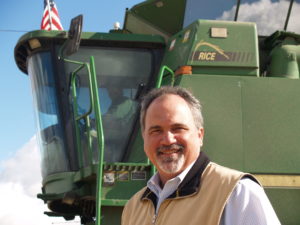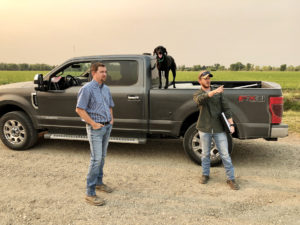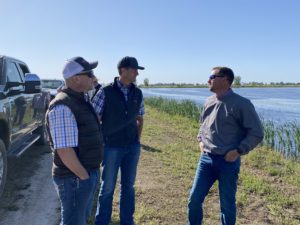Growing Together Spring 2023
Rice Growers Lead Efforts to Preserve, Build Avian Habitat
Editor’s note: This is the first in a series discussing Grow West’s affiliated industry partners and why the partnerships are important to agriculture and our customers.
Discussion and resolution of sometimes contentious issues relating to our natural surroundings often pit agriculture and environmental interests against one another and position them at opposite ends of the table, even in the presence of common ground between the two “sides.” Thus unfolds the process of reaching some kind of agreement on issues on which one side invariably feels slighted.
Waterfowl habitat in the Sacramento Valley is not one of those issues. In fact, it’s a model for the opposite: Traditionally opposing interests working together toward a common goal of sustaining natural habitat and the quantity and quality of water on which they – and its human, aquatic and avian residents – depend.
There’s a fundamental reason for such strong alignment. Aquatic and migratory birds depend on rice fields and the grain and water they contain. The preservation of that habitat is often part of the broader conversation about the convergence of agricultural and environmental interests. Agriculture — specifically rice production — is the foundation of sustaining avian habitat in the Sacramento Valley. Grow West plays a key role in maintaining the balance necessary for all species — flora and fauna — to thrive.

The story of that balance — and the farmers, ranchers and industry partners like Grow West that work together to maintain it — is not often adequately told, especially in the urban areas most Californians call home. That’s where Paul Buttner and his organization, the California Ricelands Waterbird Foundation (CRWF), come in. The group borne out of the California Rice Commission (CRC) in 2015 where CRWF Executive Director Buttner has worked for over two decades is spreading the word about the natural symbiotic relationship between the state’s rice fields and avian populations. It’s also leading farmer-driven efforts to sustain valuable habitat while ensuring the landscape can support the crop on which so many growers depend.
The 501(c)(3) leverages federal, association and industry funding and sponsorships to develop and execute conservation projects that bolster bird habitat in and around rice acres. The work demonstrates the coexistence of the crop and a diversity of birds that call the same land home. It also supports the resilience of the ecosystem by directly funding work to balance natural resources. Though an independent organization, CRWF depends on administrative and financial support from CRC.
“We are a very grassroots, rice-industry-focused conservation organization that takes financial contributions and apply them directly to conservation projects. Because we have significant administrative support from California Rice Commission, we’re able to essentially put funding right on the ground,” Buttner said. “That makes us unique; it’s also significant to our ability to make a real difference in establishing and maintaining critical bird habitat.”
Bidding for birds
The Bid for Birds program exemplifies CRWF’s work and grassroots foundation. The organization leverages support from grower contributions and sponsor partners — including Grow West — along with state and federal funding to establish conservation projects that build habitat in ways that work with rice production. Because of CRC’s in-kind support, administrative costs are low for CRWF, so the organization can put most funds toward habitat projects.
“The Bid for Birds program speaks to the unique ways we work with growers. In most cases, it’s a competitive bid process and we inform growers about what types of habitat we’re looking for based on environmental conditions, then growers submit bids,” Buttner said. “Those bids are evaluated based on cost and the quality of habitat they create, then we distribute funding via a contract with growers. Growers build the habitat and we inspect it periodically to make sure they’re in compliance.”
Those efforts have paid off. Since its inception, Bid for Birds has led to a five-fold increase in the avian habitat built or restored. The partnership has been especially valuable in bolstering the state’s drought resilience.
“Because of the infusion of state dollars, we went from less than 10,000 acres of habitat projects each year to over 50,000 acres in the last couple of years. We have put over $13 million on the ground for drought resilience in partnership with the California Department of Water Resources (DWR),” Buttner said. “The vast majority of this funding goes directly to growers taking steps to build resilient habitats for shorebirds, ducks and other species. It’s been a really nice example of what we can do working together and putting conservation dollars on the ground.”
A program with a range of benefits
Hans Herkert is one of the rice farmers who’s participated in Bid for Birds. With a few adjustments to how he manages his fields around Colusa, he’s been able to provide valuable habitat to migrating shorebirds. Financial support from the CRWF program has enabled him to create habitat and a feed source where they would normally be absent.

“We’re required to have fields covered with one to four inches of water, the perfect amount for multiple species of shorebirds to benefit as they’re migrating or getting ready for migration,” Herkert said. “They aren’t feeding on grain because it’s already been used up by waterfowl over the winter. But the water causes other organisms to thrive, so they’re scavenging for bugs.”
Though water’s been in short supply in recent years in his area, Herkert said between CRWF funding and the agronomic benefits of his specific project, it’s a practical use of natural resources with a range of benefits.
“From an agronomic standpoint, we see more decomposition of crop residue so it ties up less nitrogen in the ground that our rice crop can benefit from next year,” he said. “The biggest benefit is the habitat we’re providing to the birds. Because of Bid for Birds and how we’re flooding fields when we normally wouldn’t, we’re seeing so much more activity on the land and our crop benefits. We already have the land and space, and by just introducing water, it completely changes how the wildlife utilizes the landscape.”
Why California rice growers?
The Sacramento Valley’s rice fields are a unique combination of agricultural productivity and habitat that make growers like Herkert perfect partners in sustaining habitat and rice production. Rice fields provide optimal habitat and feed supplies for migratory birds, especially with the development of the state’s soil and water infrastructure.
“Over 90% of California’s original wetlands are gone, and Pacific Flyway wildlife has adapted. Around half a million acres of rice fields now serve as surrogate wetlands, and half of everything that ducks eat in the winter comes from those rice fields,” Buttner said. “Growers would love to collect every last grain, but when harvesting, there’s always some waste grain in the field. That grain is an extremely important nutrient resource for wintering ducks.”
Herkert already has plans for continuing with Bid for Birds based on the success of his recent efforts. For him, it’s all about positively influencing the land with a fairly minor adjustment to how he grows rice.
“It’s such a good opportunity. It’s not a huge money-maker or profit center for the farm, but it’s a diversification into something that really maximizes the benefits to the habitat we can create,” Herkert said. “That’s really exciting and fulfilling to me.”
Promoting grower benefits to the non-farm population
Connecting CRWF and CRC’s collaborative work on programs like Bid for Birds, Buttner said, will hopefully bring downstream benefits from policy and regulatory standpoints.

“Most of the residents of California aren’t connected to agriculture, so if we’re going to be truly relevant to them, we need to demonstrate that we are taking good care of the water resources out here in the Sacramento Valley. Cleaner air, water and wildlife are what we are all about,” he said. “All of these environmental benefits don’t happen without water. We can enable Californians to understand all the benefits of what we’re doing together to help maintain reliable water supplies for our crops and the wildlife they support. In a state with a lot of competing interests and demands for water, I think we have to continue to demonstrate the value of our programs and the positive difference they make to our state’s water supply.”
The partnership with and support from Grow West enable Buttner and CRWF to do what they do in sustaining habitat and demonstrating the effectiveness and importance of their efforts. A multi-year, ongoing sponsor of the foundation, Grow West’s contributions are matched with state funding and grower contributions that enable CRWF — with support and direction from the California Rice Commission — to continue to raise awareness about farmers’ roles in sustaining the state’s water supplies and wildlife habitat. It’s a massively important message to share with all Californians.
“The California Rice Commission and sponsors like Grow West provide the funding to lay the foundation necessary for our efforts to be successful,” Buttner said. “Everyone contributes and works in concert with one another for the benefit of rice growers and the environment.”
